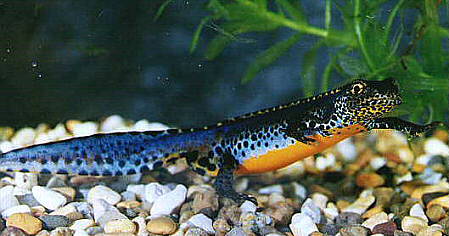
This is a gorgeous male Italian Alpine (T.a.apuanus)
by Marc S Staniszewski
Description:
The genus Triturus is a relatively small Eurasian group which contains
some of the most spectacular transformations in the animal world. From relatively dull
subterranean denizens to beautiful adorned and colored water creatures, newts are popular
vivarium subjects throughout the world. One of the most attractive, both on land and
especially in its aquatic form is the small but extremely distinctive species - the Alpine
newt (Triturus alpestris). The term 'Alpine` is slightly misleading because
although occurring in the mid and lower elevations of that mountain range they also dwell
vast regions of lowland and other mountain ranges throughout Europe and Western Russia.
The Alpine Newt Complex
Alpine newts are currently split up into ten different subspecies. Only three subspecies are regularly available in captivity, almost of an entirely captive-bred derivation;
The nominate form - the Alpine newt (Triturus alpestris
alpestris) possesses the widest range, from Denmark, the Benelux countries
(Belgium, Luxembourg and Holland), to northern Greece and eastern Russia. This 9 - 12.7cm
(3.53 - 5in) newt’s dorsal coloration varies from drab brown in females to a
beautiful marbled arrangement of iridescent blue mottling in males. Females also tend to
have a granular skin texture as opposed the velvety texture of males. The underside varies
from a yellow-orange in females to a deep blood-red orange in males and speckles are
completely absent. During courtship males develop a low (1½ - 2mm) crest consisting of
sequential yellow and black bars.
Northern Italy is inhabited by the Italian Alpine (T.a.apuanus)
which at a maximum of 10cm is smaller than the nominate form. It is also more aquatic than
T.a.alpestris often spending the entire year in cool ponds. Females are larger and
duller than males possessing flaccid folds of skin on the head, abdomen and limbs. Dorsal
color is dull brown with black blotches along the flanks where the venter is a tangerine
hue, In contrast males are slim, elegant and the most attractive Alpine newt when in
courtship (which is most of the year). Their dorsal colours comprise of opalescent silver
and blue mottling with sky blue along the lower flanks. At the edges of the vivid orange
venter (which is heavily spotted on the throat) is a band of silvery white with black
speckling (which extends to the head, legs and cloaca). The lemon-colored crest is 2 - 3mm
high with uniform black zigzags. The tail also shows heavy blue and black blotched
cresting. Even the eyes do not escape transformation, enlarging and turning gold.

This is a gorgeous male Italian Alpine (T.a.apuanus)
The Spanish Alpine (T.a.cyreni) is a classic
example of detachment from the rest of the population and can be only be found in and
around Lake Ercina and several smaller connecting lakes around Covadonga in the Cantabrian
Mountains of Northwest Spain (altitudes 3,200 to 4,122 feet). It was thought to have been
stranded during the final glaciation of northern and central Europe at the end of the
Pleistocene Epoch some 20,000 years ago and was unable to advance back across its former
range. Although not unduly different from the nominate form in terms of coloration, the
smaller length, broader more rotund body and insularity have gained it subspecific status.
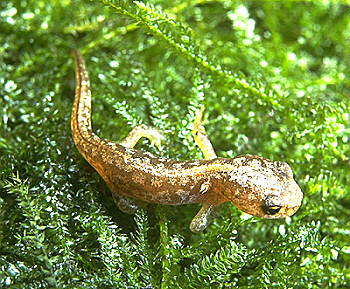
A juvenile Spanish Alpine newt (T.a.cyreni)
As with T.a.cyreni, the following subspecies consist of relict populations
occurring in isolated high mountain lakes. Due to the restricted ranges they are rarely,
if ever, offered for sale and are described merely for information purposes;
The Yugoslavian Alpine (T.a.lacusnigri) is the
rarest form and only occurs in an extremely restricted location near Crno Jezero in the
Julian Alps. In appearance it is by far the darkest form with some individuals showing a
very dark blue, grey or even black dorsum. This ties in with the surrounding pine woodland
habitat which consists of a very rich dark humus within which this newt dwells. At 13½cm
(5.31in) it is the second longest form but is very slim-line with a disproportionately
large head.
Three neotenous forms occur in Montenegro. The 7 - 9cm Montenegran
Alpine (T.a.montenegrinus) was established in 1951 by the Yugoslavian
biologist Radovanovic who documented the discovery of a completely neotenic form in Lake
Bukumirsko, Montenegro. Recently two more forms have been described, thought to be
distinct from the Lake Bukumirsko form - T.a.piperianus
and T.a.sedarus. Their current status may be
controversial as they are separated from T.a.montenegrinus only by land locks.
Coloration of T.a.montenegrinus is in line with the nominate form yet the massive
head has developed into a specialist aquatic tool with the mouth shrinking to form largely
immobile, circular opening which is used to suck in water crustaceans and other
invertebrates which are then crushed by specialized vomero-palatine teeth.
The large Bosnian Alpine (T.a.reiseri) is also
equipped with a enlarge head. In size and build is more comparable with a marbled newt and
tends to be the dominant carnivore in many of its small pool habitats throughout the
Bosnian Vranika mountains. Cannibalism is a familiar behavioral trait of this form and in
some colonies appears to be the main way of keeping populations in check.
The Greek Alpine (T.a.veluchiensis) - occurs at
round 6,000 feet in the Veluchi Mountains of Central Greece where it is apparently locally
abundant. The main characteristic of this 10 - 12cm (3.94 - 4.72in) subspecies is that
females are almost equal in colour to the male and certainly possess the pearl and sky
blue bands along the lower flanks.
The Calabrian alpine newt (T.a.inexpectatus)
occurs in central Italy and Calabria in southern Italy. This subspecies has only recently
and controversially been named as externally it appears to be no different from T.a.apuanus.
Captive Care
Housing
Alpine newts are hardy amphibians tolerant of a wide range of waters including frozen,
stagnant or polluted ponds. In captivity they thrive in a large aquarium (50 - 70 gallon
aquarium) which should consist of half land : half water for T.a.alpestris and T.a.cyreni
or a third land : two-thirds water for the T.a.apuanus. Locate it somewhere which
receives good light but not direct sunlight. Alternatively a natural daylight (UV) tube
can be position over the entire set-up. The water depth should be 38 - 51cm (15 - 20in)
with an undergravel/sand filtration-aeration unit being incorporated into the set-up. As
Alpine newts deposit their eggs on any suitable aquatic vegetation such as Elodea
canadensis and E.densa.
The terrestrial section must be easily accessible and could either be a gradually sloping
shelf or a suitable moss-lined rock which ascends just above the water level. Alpine newts
show a preference for cool conditions - 55 - 65°F. (12.8 - 18.3°C.). During summer this
may be prove impractical, so adding a block of ice or partial changes with cool the water
at regular intervals (i.e. at least once daily) will assist in maintaining cool conditions
and good water quality. Every so often month it may be necessary to thoroughly clean
rocks, gravel/sand and rinse or change vegetation.
Lighting
There is certainly no requirement for UVB lighting (unless live plants are
maintained in the terrarium) because alpine newts are primarily nocturnal or crepuscular.
Locating the terrarium in a well lit place (but not in direct sunlight) will provide them
with the photoperiods necessary to promote breeding. When the adults are in the aquatic
courtship phase, the aquarium can be placed under lights to promote aquatic plant growth
but provide dark hiding places for the newts.
Feeding
Chopped worms, water crustaceans (Gammarus, Asellus and Daphnia),
bloodworm, tubifex, small water snails and strips of raw, lean meat offered with tweezers
are taken in the aquatic stage. They also enjoy various insects or spiders which stray on
to the water surface. In the terrestrial state they hunt small worms, slugs, woodlice,
crickets, spiders, freshly-sloughed mealworm and waxworm. At every third or fourth sitting
the prey can be lightly dusted in a multi-vitamin supplement.
Courtship & Breeding
Courtship and egg-laying usually result when water temperatures exceed 36°F. (2.2°C.).
Below this they become sluggish while remaining active, but continue to feed. During
courtship the female may collect a number of spermatophores from several different males
and is able to store these for up to four months in a specialized repository within her
cloacal region called the receptaculum seminis. On fertilization she produces and
individually wraps her 2mm grey-cream eggs within the foliage of any suitable aquatic
plant and especially within narrow strips of plastic which are tied around a length of
string submerged in the water. It is worth removing some eggs to separate rearing aquaria
if space permits as adult alpine newts are especially fond of their own eggs. All three
subspecies lay 100 - 175 eggs.
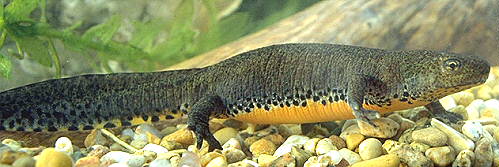
Italian Alpine (T.a.apuanus) - notice the difference
between the breeding female (above) and the male (below).
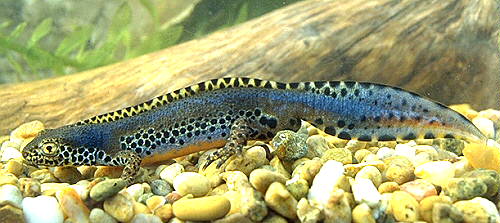
Hatching is slow in cold water although higher temperatures may reduce successful hatching
rates. Initially larvae are 5mm greyish splinters which hang motionless to the sides of
the aquarium, rocks or plants as they absorb their yolk sac. Within 10 days they are
active predators feeding on microscopic invertebrates. Development can take as long as 40
- 80 weeks in very cold water during which time they should be given copious amounts of
Daphnia, bloodworm, tubifex (in floating holders) and brine shrimp. Newly-metamorphosed
newts measure from 3 - 8cm (1.18 - 3.15in) depending on development duration. They are
best reared in plastic gallon ice-cream containers filled with moist live sphagnum moss
where they can continue to feed on bloodworm, chopped earthworm and small waxworm.
Maturity is achieved in as little as 18 months in the T.a.apuanus, while 3 years is
the norm.
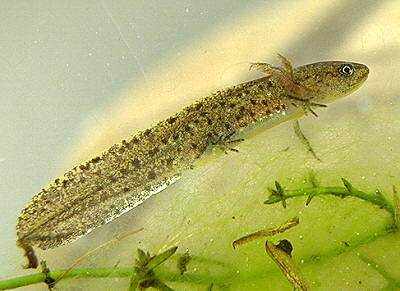
A well-developed larvae of the alpine newt (T.a.alpestris)
Other Comments
Due to their relatively slow life pattern, Alpine newts have a recorded longevity of 20
years particularly where cooler conditions are prevalent.
References
Information gathered from the following books/persons was used in the generation of this page.
1.) Newts and Salamanders of Europe - Richard Griffiths (Poyser Natural
History)
2.) A Field Guide to the Reptiles & Amphibians of Britain & Europe -
Arnold/Burton/Ovenden - (Collins)
3.) The Tailed Amphibians of Europe - J.W.Steward (David & Charles)
4.) Europaische Amphibien und Reptilien - Ludwig Trutnau - (Belser Verlag)
| 5.) Amphibians in
Captivity (TFH) - Marc Staniszewski (1995) |
![[image]](Images/tfhbook.jpg) |
All text and photo's - Copyright ©1996-8 Marc Staniszewski
Most recent revision: 30/09/98
Back to my Personal File